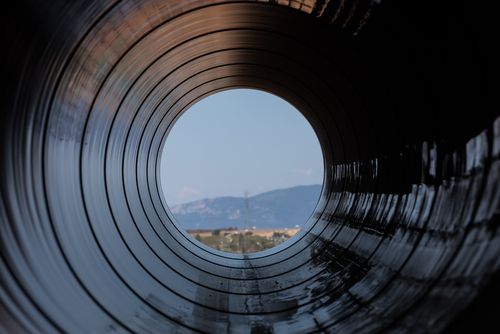What Is CIPP Lining?
Cured-In-Place Lining is the most technologically advanced method of repairing water and waste pipes today. The installation process creates a new “pipe within a pipe” using trenchless technology. The process and the resulting pipeline come with multiple benefits in comparison to traditional pipe repair and replacement techniques.

How CIPP Works
Technicians begin the CIPP installation process by cleaning out the pipe. Attempting the installation without cleaning out the pipe will result in a failed pipe restoration. The pipe needs to be clean so the resin will coat it evenly and cure. Abrasive cleaning methods may be used to remove corrosion, rust, or grease.
Once the pipe is clean, the technicians will insert a video camera into the pipe to find the sources of damage. This information tells them where repairs need to be made. One of the advantages of CIPP pipelining is that you can either repair small areas of damage or the entire pipe length.
Once the technicians determine the area needing repair, they insert a tube that is coated with the repair material into the pipe. They then insert a balloon or “bladder” into the pipe which holds the tube in place against the pipe. This coats the damaged pipe with the repair material and holds it in place until it cures. Depending on the material, it usually takes between two and three hours to cure.
Once the material is completely dry, the balloon is deflated and removed. The technicians might insert the video camera to ensure the process sealed the damage and left a solid, durable pipe in place of the old damaged one.
When it comes to CIPP lining, the process offers numerous benefits in comparison to trenching. Although there are some situations that aren’t right for CIPP liners, these situations often work well with other trenchless solutions. Before you decide on a method of repair or replacement, have the experts in trenchless pipe solutions make a diagnosis of your water system.
Identifying Sewage Problems
Sometimes sewage problems are easier to identify than others. The longer you ignore signs of a leaking sewage system, the worse the damage will be. You might not know what to do when trouble occurs. But you can learn what to look for and know when it’s time to call for help.
– Funny Sounds
If you hear the sound of water running but can’t find the source, it might be a leak inside your building or in the sewer pipes.
– A “Squishy” Floor
If your floors feel spongy or moist, it’s often due to a sewage leak. If the problem is with a link to the sewer main, water can seep around the connection, resulting in moisture in your floors.
– Bad Smells
It’s no surprise that sewage has an unpleasant odor but foul odors in your house could be from mold and mildew that grow in response to sewage leaks. Sometimes you can detect the odors outdoors as well.
– Rodent Problems
Rodents love the smell of leaking sewer lines. The smell can lure them to the site of trouble before you realize there is a problem. If you develop a rodent problem out of the blue, you probably have sewer problems too!
– Cracks in Your Foundation
Dripping sewer lines lead to pooling in the soil around your home. This causes the house to shift and leads to cracks in its foundation. It can also cause damage in concrete patios, sidewalks, or driveways.
– Changes in Your Landscaping
If you have unusual growth accompanied by wet, sunken patches, it’s probably a result of sewer pipe failure. The “natural fertilizer” coming from the sewage often causes the grass and plants to appear lusher. In spite of their healthy appearance, there’s often nasty bacteria waiting to destroy your lawn and garden.
– Higher Water Bills
If your water bill spikes for no apparent reason, it’s a good indication that there’s a leak. It doesn’t take a big leak to add up to a noticeably higher cost.

Top Reasons to Choose CIPP Trenchless Pipelining
1. Lower Installation Costs
Initially, opting for the traditional trench replacement might sound like the more cost-effective approach to pipe repair and replacement. But the actual costs vary according to several factors. Those same factors are what make pipelining the most affordable option overall. It involves a much faster process that doesn’t entail digging up your landscaping, driveway, or the street out front. That means less of an expense for tearing it up and for restoring it again once the pipe is in place. It also greatly reduces the cost of labor and equipment.
2. Works for Multiple Types of Pipe Damage
CIPP pipelining works on any type or size of pipe. There are no worries about the size or placement of the existing pipe. A Perma-line repair works in any pipe and in almost any situation. Some common reasons for pipe damage include corrosion, rust, deterioration with age, cracks, pinholes, fractures, and root or plant intrusion.
One of the biggest advantages of CIPP lining is its compatibility with all types of pipes. It’s just as effective at lining metal pipes with corrosion damage as it is plastic pipes with cracks. Once the liner is in place, the damage disappears and you have a brand new pipe in its place.
3. Faster, More Efficient Results
Digging up pipes is a time-intensive process. It starts with dialing 811 before you dig to make sure you don’t run into gas lines or other underground systems. Pipelining, on the other hand, can be completed without the risk of running into unmapped gas or other underground service systems. In just a few hours and with minimal digging, the pipeliner is applied, cured, and ready to use.
4. Long-Lasting Solutions
If you live in an older home, the odds are good that your pipe system has at least one type of damage. Every type of pipe material has a lifetime, including the galvanized pipes used in most older homes. You have the choice of replacing the existing pipes with new plastic ones that will last for decades. You can also apply a pipeliner without the need to excavate the existing lines and get the same long-lasting results.
When you have your CIPP pipeliner installed by experienced professionals, you’ll have a new, jointless pipe in place of the old, damaged one. Your new pipe will be resistant to corrosion, rust, and other types of damage that cause problems with other types of pipes. You’ll have the peace of mind in knowing that your cured-in-place repair will last fifty years or longer. That’s a pretty good return on your investment for a process that only lasts a few hours.
5. A Safer Process for You and the Workers
You never know exactly what you’ll come across when you dig underground. That’s especially true when you don’t know how long the problem has had to grow. Any time you engage in a large excavation, there’s a risk of exposure to mold, asbestos, and other dangerous natural elements. You also have the risk of running into gas lines, electrical systems, and other dangers. There’s even the danger from heavy equipment used in the excavation process.
Lining your existing pipe removes the risk to you, your family, and the workers responsible for the installation. The process usually requires one to three small holes where the equipment is inserted into the pipe. There’s no busting up concrete or bringing traffic to a stop. It’s always the safest option for everyone involved.
6. Processes for Different Solutions
Different situations call for a variety of processes. CIPP lining offers solutions for several. Perma-liner liquid repairs entire water lines from your home to the main water line. It works for smaller pipe damage and in larger pipes where other repairs aren’t easily managed. Sectional point repair and manhole-to-manhole lining are some of the options available. Ask the local pipelining technicians which method of CIPP pipelining is the right solution for your situation.
7. Solutions for Large Buildings
Large, multi-family units and large-scale businesses often have complex pipe systems in place. When damage occurs, finding and repairing the damage requires extensive digging, tearing through walls, and doing significant damage to the building.
CIPP is not only a great solution for homes but also for all types of commercial buildings. It provides the repair needed to restore your pipe system in a matter of a few hours. There’s no damage to your building’s structure, floor, or walls. You save a lot of time and money, not to mention, make your tenants a lot happier without the major excavation.
8. It’s Available from Experts Near You
There’s nothing worse than reading about some great new technology that hasn’t made it to where you live. Trenchless pipelining has grown significantly in popularity over the past decade. As a result, you have access to some of the most experienced experts in the field close to you.
If you notice signs of a damaged water pipe system, contact San Diego Pipelining. We offer a variety of trenchless pipelining solutions to meet a variety of needs!
